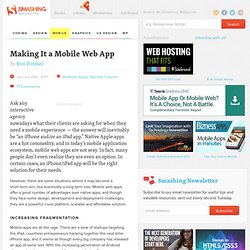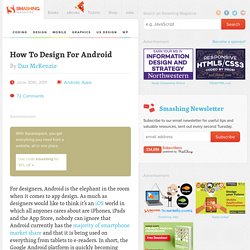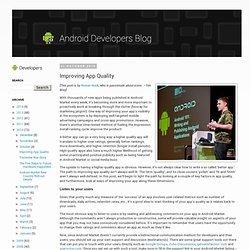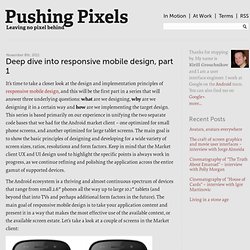Zoom
Trash

Android Developers — Visual Design Screencast — Creating custom button assets. DesignBytes: Flattening Existing Icons with Photoshop. Making It a Mobile Web App. Advertisement Ask any interactive agency nowadays what their clients are asking for when they need a mobile experience — the answer will inevitably be “an iPhone and/or an iPad app.”

Native Apple apps are a hot commodity, and in today’s mobile application ecosystem, mobile web apps are not sexy. In fact, many people don’t even realize they are even an option. In certain cases, an iPhone/iPad app will be the right solution for their needs. However, there are some situations where it may become a short-term win, but eventually a long-term loss. Increasing Fragmentation Mobile apps are all the rage. But what about deploying to Windows Phone 7, Blackberry and Symbian? GAP StyleMixer application for both iOS & Android The Mobile Web is Everywhere As the native mobile app market becomes increasingly fragmented, it is becoming clear that there needs to be a solution which can re-use code and designs across platforms, and which eases deployment headaches. Old News The App Store Model (ik)(vf) Designing For Android. For designers, Android is the elephant in the room when it comes to app design.

As much as designers would like to think it’s an iOS1 world in which all anyones cares about are iPhones, iPads and the App Store, nobody can ignore that Android currently has the majority of smartphone market share2 and that it is being used on everything from tablets to e-readers. In short, the Google Android platform is quickly becoming ubiquitous, and brands are starting to notice. But let’s face it. Android’s multiple devices and form factors make it feel like designing for it is an uphill battle. And its cryptic documentation3 is hardly a starting point for designing and producing great apps.
Further Reading on SmashingMag: Link If all this feels discouraging (and if it’s the reason you’re not designing apps for Android), you’re not alone. This article will help designers become familiar with what they need to know to get started with Android and to deliver the right assets to the development team. Improving App Quality. [This post is by Roman Nurik, who is passionate about icons.

—Tim Bray] With thousands of new apps being published in Android Market every week, it’s becoming more and more important to proactively work at breaking through the clutter (hooray for marketing jargon!). One way of improving your app’s visibility in the ecosystem is by deploying well-targeted mobile advertising campaigns and cross-app promotions. However, there’s another time-tested method of fueling the impression-install-ranking cycle: improve the product! A better app can go a very long way: a higher quality app will translate to higher user ratings, generally better rankings, more downloads, and higher retention (longer install periods). The upside to having a higher-quality app is obvious. Listen to your users The most obvious way to listen to users is by reading and addressing comments on your app in Android Market.
Another way to better listen to your users is by having a public beta or trusted tester program. Android Interaction Design Patterns. Deep dive into responsive mobile design, part 1. November 8th, 2011 It’s time to take a closer look at the design and implementation principles of responsive mobile design, and this will be the first part in a series that will answer three underlying questions: what are we designing, why are we designing it in a certain way and how are we implementing the target design.

This series is based primarily on our experience in unifying the two separate code bases that we had for the Android market client – one optimized for small phone screens, and another optimized for large tablet screens. The main goal is to show the basic principles of designing and developing for a wide variety of screen sizes, ratios, resolutions and form factors. Keep in mind that the Market client UX and UI design used to highlight the specific points is always work in progress, as we continue refining and polishing the application across the entire gamut of supported devices.
This is a screenshot of the application details page. What happens on a larger form factor? Android niceties.